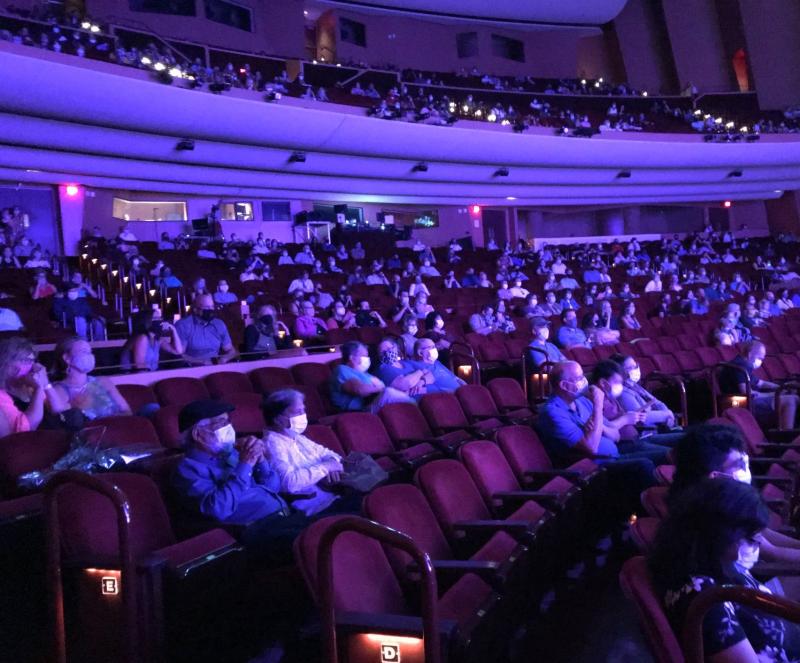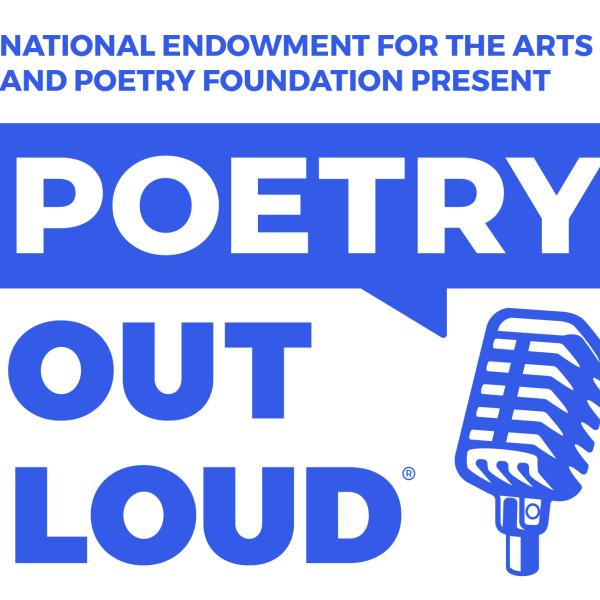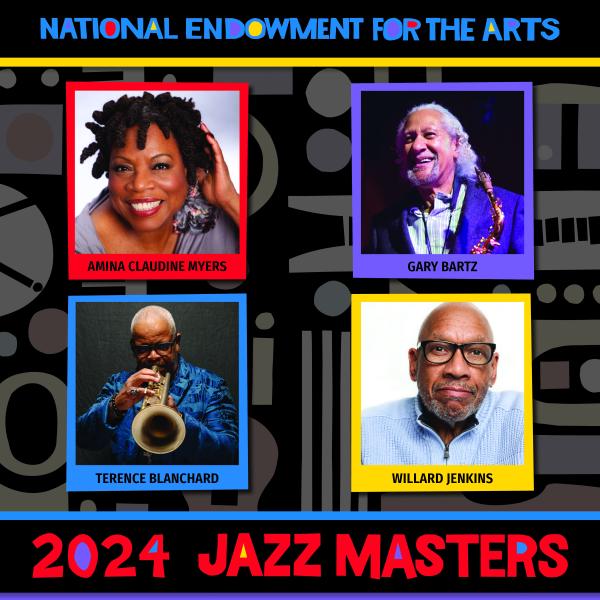New Data Reveal How Adults Participated in the Arts During COVID-19

A masked audience watches a performance at the Lied Center for Performing Arts in Lincoln, Nebraska, in 2020. Photo courtesy of the Lied Center for Performing Arts at University of Nebraska.
Washington, DC—What was the impact of COVID-19 on arts participation? New research released today by the National Endowment for the Arts (NEA) notes that between July 2021 and July 2022, more than half of all adults created and/or performed art—similar to findings in 2017, the last time the survey was conducted. During the same time period, just under half of all adults attended in-person arts events, a significant drop from 2017. A separate survey shows that 82 percent of respondents watched or listened to arts activities through digital media between 2021 and 2022. These and other findings about in-person and virtual arts participation, and about adults’ reading habits, are available in two new NEA research publications: Arts Participation Patterns in 2022: Highlights from the Survey of Public Participation in the Arts and Online Audiences for Arts Programming: A Survey of Virtual Participation Amid COVID-19.
Chair of the NEA, Maria Rosario Jackson, PhD, said, “The National Endowment for the Arts has a longstanding commitment to providing the arts and culture field and the general public with accurate and relevant research. Taken together, these reports help to reveal the state of arts participation in our country and serve as an important resource in understanding areas that are growing in interest, those that showed a decline, as well as demographic gaps in participation, among other trends.”
Arts Participation Patterns in 2022: Highlights from the Survey of Public Participation in the Arts
Since 1982, the Survey of Public Participation in the Arts (SPPA) has been administered roughly every five years by the U.S. Census Bureau. This report is the first look through the lens of federal survey data at how adults participated in arts activities for one year of the pandemic: a 12-month period from July 2021 to July 2022. The report examines areas such as attending arts events, personally creating or performing art, reading books or literature, watching or listening to arts content via media, or learning an art form. A comprehensive statistical report of the 2022 SPPA data will be released next year.
Key findings from this report include:
Art Making:
- More than half (52 percent) of the nation’s adults did some form of art making in 2022. This is similar to the share of adults who, using a different set of measures, reported creating and/or performing art in 2017.
- For most art forms, the share of adults personally creating and/or performing has either grown modestly or held flat since 2017. Art making activities that showed growth from 2017 included leatherwork, metalwork, and woodwork. and playing musical instruments. Other activities, such as working with textiles, taking artistic photos, or doing creative writing, took a dip in 2020 but have since returned to 2017 levels.
- Social dancing is the most popular activity across all forms of personal arts performance and creation, involving 22 percent of adults.
- The next most popular activity is singing, whether alone or in a choir, though the proportion of adults singing declined by five percentage points from 2017 to 2022.
- Other declines in personal creation and performance included performing or practicing dance; restoring, rebuilding, or customizing objects; and cooking as an artistic activity.
- Most adults who learned an arts subject did so through friends or family, or by teaching oneself.
Arts Attendance—In-person:
- Just under half (48 percent) of all adults attended at least one arts event in person. This is six percentage points less than reported in 2017.
- Attendance rates declined in comparison to 2017 for virtually every type of arts activity specified in the survey—art museum or gallery visits, and attendance at jazz, classical, or Latin/salsa music performances, musical and non-musical plays, craft fairs and outdoor performing arts festivals, operas, and ballet and other dance forms, and movies.
- However, attendance rates grew 15 percent, to 21 percent of adults, for the “other” performing arts category. This could include all kinds of music, dance, and theater events not specified by the survey, such as rock or pop, rap or hip-hop, folk or country, or music from other countries and cultural traditions, in addition to comedy/improv, circus acts, or magic shows.
- As for visual arts attendance, the only activity not to see a severe decline was visits to parks, buildings, monuments, or neighborhoods for historic or design purposes—this participation rate slipped by only two percentage points.
- In 2022, open-air facilities (e.g., parks, pavilions, amphitheaters) were among the most popular sites of in-person arts attendance.
- Social media and peer-to-peer communications were the most commonly cited mechanisms for learning about in-person arts events that survey respondents attended.
Arts Consumption Via Media:
- As in prior years, the largest share of adults who participated in the arts did so by consuming art through electronic or digital media (75 percent).
- The rate of music-listening via electronic or digital media held steady between 2017 and 2022, with the exception of jazz and classical music or opera, which saw declines.
- Many other forms of arts consumption via media saw declines in the five-year period, including watching or listening to theater productions and dance performances, as well as programs, podcasts, or other video or audio content about the visual arts or about books or writers.
Reading:
- In 2022, 53 percent of U.S. adults read literature and/or books of some kind (compared to 57.1 percent in 2017).
- Data indicate a sharp decline in reading over the last decade. The percent of U.S. adults who read at least one book (in print or electronically) in 2022 was 48.5, 6.1 percentage points lower than in 2012.
- The percent of U.S. adults who read literature—novels or short stories, poetry, and plays—was lower in 2022 than in 2017. In particular, the percent of U.S. adults who read novels or short stories declined at a 17 percent rate, from 45.2 percent in 2012 to 37.6 percent in 2022—the lowest share on record with the survey.
- The percent of U.S. adults who read poetry dropped to 9.2 percent in 2022 from 11.7 percent in 2017, but remained above the 2012 level of 6.7 percent. A new survey question for 2022 asked about poetry listening, with 4.8 percent of adults (11.8 million) reporting having listened to poetry via broadcasts, recordings, or web streaming. (More information is available in the April 2023 NEA blog post: New Survey Reports Size of Poetry’s Audience – Streaming Included)
Demographic Differences:
- Companion tables to this report examine arts attendance by different demographic groups. For most activity/event types, the declines seen in arts attendance were borne by both genders, Whites, older adults, and those with higher education levels. Exceptions include:
- Musical plays; classical music; outdoor performing arts festivals, and craft fairs—declines were also seen in Hispanic attendees
- Non-musical plays and Latin music—declines were also seen in younger age groups
- Non-ballet dance forms—declines were also seen in African American and Hispanic attendees, and in younger adults
- Art museums and galleries—declines were also seen in African American and Asian visitors
Raw data for the full 2022 Survey of Public Participation in the Arts will be available later this year at the NEA’s National Archive of Data on Arts and Culture.
Online Audiences for Arts Programming: A Survey of Virtual Participation Amid COVID-19
The 2022 General Social Survey (GSS), administered by the National Opinion Research Center (NORC) at the University of Chicago, is another tool for understanding arts participation. Supported by the NEA in partnership with the National Science Foundation, the 2022 GSS Arts Module asked respondents to reflect on their arts experiences during the first year of the pandemic (from March 2020 to March 2021) and to report whether, in the most recent 12-month period, they participated at a higher, lower, or identical rate. The report also examines how responses varied by demographic subgroup.
Key findings from this report include:
- 82 percent of respondents attended some type of digital arts activity between 2021 and 2022, such as: viewing or listening to archived and livestreamed web performing arts events; listening to arts-related podcasts; viewing or listening to archived and livestreamed web reading events; taking online art classes; and attending online art exhibits or tours. (This is roughly comparable to the 75 percent of adults reporting engagement with digital arts activities in the 2022 SPPA, which used different question-items and methods.)
- The greatest share of adults (70 percent) attended web-archived performing arts events, followed by 43 percent attending livestreamed performing arts events. (70 percent is updated from 69 percent using the GSS 2022 Cross-section data Release 2, which was released November 2023.)
- Roughly 30 percent of respondents reported doing one or more digital arts activities more often than in the first year of the pandemic.
- A higher rate of women; 18- to 24-year-olds; African American, Hispanic, and non-White, non-Hispanic adults reported participating in virtual arts events—and reported doing so more often than in the first year of the pandemic.
- Overall, a slightly larger share of women than men reported engaging with any type of digital arts activity. This trend was consistent across many digital activity types, except for watching or listening to livestreamed performing arts events.
- More women than men reported participating in one or more digital arts activity more often than in the first year of COVID-19.
- Adults aged 18-24 reported higher rates of engagement with digital arts activities than did older age groups and also were also more likely than other age groups to say they now did these activities more often than in the first year of the pandemic.
- Almost all Black/African Americans and other non-Hispanic and non-White respondents, and the vast majority of Hispanic respondents, reported engaging with at least one type of digital arts content over the most recent 12-month period.
- Roughly half of all Black/African American and other non-Hispanic and non-White respondents, and over a third of Hispanic respondents, reported doing one or more digital activity more often than in the first year of the pandemic—compared to 24 percent of White respondents.
- Respondents from all educational backgrounds reported strong engagement with digital arts activities, with those with graduate degrees reporting the highest rate and those with less than a high school diploma reporting the lowest. Nevertheless, 42 percent of adults who had not earned a high school diploma said they now engaged with one or more digital arts activities more often than in the first year of the pandemic, which was the highest rate for any education group. (42 percent is updated from 41 percent using the GSS 2022 Cross-section data Release 2, which was released November 2023.)
About the National Endowment for the Arts
Established by Congress in 1965, the National Endowment for the Arts is the independent federal agency whose funding and support gives Americans the opportunity to participate in the arts, exercise their imaginations, and develop their creative capacities. Through partnerships with state arts agencies, local leaders, other federal agencies, and the philanthropic sector, the Arts Endowment supports arts learning, affirms and celebrates America’s rich and diverse cultural heritage, and extends its work to promote equal access to the arts in every community across America. Visit arts.gov to learn more.
Contact
Liz Auclair, auclaire@arts.gov, 202-682-5744




